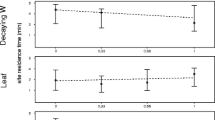Summary
A continuum concept of spatial organization linking territoriality and social hierarchy suggests that individuals will alter their degree of exclusiveness and priority of access to resources in accord with the net benefits of aggression. Thus changes in resource distribution will produce changes in the control of resource space for any one individual. Similarly when comparing among individuals, responses will change in accord with their aggressive abilities when compared to those of possible opponents. The existence of such a continuum model of spacing was investigated in a nectar feeder, the New Zealand bellbird (Anthornis melanura: Meliphagidae). A natural change in spatial distribution of resources from highly concentrated to dispersed provided an opportunity to follow changes in access for known individuals. Comparison of individuals of different hierarchical status, sex and residential status was also possible within each system as was an estimate of comparative rewards. At the concentrated resource, individuals could be ranked in a dominance hierarchy although spatial separation between more dominant individuals did occur. At the more spatially dispersed resource, most individuals obtained a level of exclusive use. Access to both resources varied for different individuals but the asymmetries that related to greater access in one system also produced greater access in the other resource.
Similar content being viewed by others
References
Angehr G (1985) The diet of three species of honeyeater. NZJ Zool 12
Brown JL (1963) Aggressiveness, dominance and social organization in the Stellar's jay. Condor 65:460–484
Brown JL (1964) The evolution of diversity in avian territorial systems. Wilson Bull 76:160–169
Brown JL, Orians GH (1970) Spacing patterns in mobile animals. Ann Rev Ecol Syst 1:239–262
Carpenter FL, MacMillen RE (1976) Threshold model of feeding territoriality and test with a Hawaiian honeycreeper. Science 194:639–642
Craig JL (1985a) Wing slots of bellbirds. NZJ Zool 12
Craig JL (1985b) Status and foraging in New Zealand honeyeaters. NZJ Zool 12
Craig JL, Douglas ME (1984) Temporal partitioning of a nectar resource in relation of competitive asymmetries. Anim Behav 32:624–625
Craig JL, Stewart AM, Douglas ME (1981a) The foraging of New Zealand honeyeaters. NZJ Zool 8:87–91
Craig JL, Douglas ME, Stewart AM, Veitch CR (1981b) Specific and sexual differences in body measurements of New Zealand honeyeaters. Notornis 28:121–128
Davies NB (1978) Ecological questions about territorial behaviour. In: Krebs JR, Davies NB (eds) Behavioural Ecology: an evolutionary approach, Blackwell Scientific Publications, Oxford, pp 317–350
Davis DE (1958) The role of density in aggressive behaviour of house mice. Anim Behav 6:207–210
Davis DE (1959) Territorial rank in starlings. Anim Behav 7:214–221
Emlen JT (1957) Defended area? A critique of the territory concept and of conventional thinking. Ibis 99:352
Esler AE (1978) Botanical features of Tiritiri Island, Hauraki Gulf, New Zealand. NZJ Bot 16:207–226
Ewald PW, Carpenter FL (1978) Territorial responses to energy manipulations in the Anne hummingbird. Oecologia 31:277–290
Ewald PW, Orians GH (1983) Effects of resource depression on use of inexpensive and escalated aggressive behaviour: Experimental tests using Anna humminbirds. Behav Ecol Sociobiol 12:95–101
Ewald PW, Rohwer S (1980) Age, coloration and dominance in nonbreeding hummingbirds: a test of the asymmetry hypothesis. Behav Ecol Sociobiol 7:273–279
Gill FB, Wolf LL (1975) Economics of feeding territoriality in the golden-winged sunbird. Ecology 56:333–345
Greenberg B (1947) Some relations between territory, social hierarchy, and leadership in the green sunfish (Lepomis cyanellus). Physiol Zool 20:267–298
Kaufman JH (1983) On the definitions and functions of dominance and territoriality. Biol Rev 58:1–20
Leyhausen P (1971) Dominance and territoriality as complemented in mammalian social structure. In: Esser AH (ed) Behaviour and environment, Plenium Press, London, p 22–33
Maynard Smith J, Parker GA (1976) The logic of asymmetric contests. Anim Behav 24:159–175
Miller SJ, Inouye DW (1983) Roles of the wing whistle in the territorial behaviour of male broad-tailed hummingbirds (Selasphorus platycercus). Anim Behav 31:689–700
Pyke GH (1979) The economics of territory size and time budget in the golden-winged sunbird. Am Nat 114:131–145
Stamps JA (1977) The relationship between resource competition, risk and aggression in a tropical territorial lizard. Ecology 58:349–358
Wolf LL (1978) Aggressive social organization in nectarivorous birds. Am Zool 18:765–778
Wolf LL, Walz EC (1984) Dominions and site-fixed aggressive behavior in breeding male Leucorrhinia intacta (Odonata: Libelludae). Behav Ecol Sociobiol 14:107–115
Zahavi A (1971) The social behaviour of the white wagtai Motacilla alba alba wintering in Israel. Ibis 113:203–211
Author information
Authors and Affiliations
Rights and permissions
About this article
Cite this article
Craig, J.L., Douglas, M.E. Resource distribution, aggressive asymmetries and variable access to resources in the nectar feeding bellbird. Behav Ecol Sociobiol 18, 231–240 (1986). https://doi.org/10.1007/BF00290827
Received:
Accepted:
Issue Date:
DOI: https://doi.org/10.1007/BF00290827




